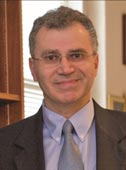Bigelow Lecture by
John A. Elefteriades:
“Thoracic Aortic Aneurysms:
Reading the Enemy’s
Playbook”

John Elefteriades
|
John Elefteriades is the
William Glenn Professor of
Surgery at Yale University.
He is an aorticist who
graduated from Yale
Magna Cum Laude as a
triple major in Physics,
French, and Psychology.
He serves as the Director of
the Aortic Institute of Yale
– New Haven, and editorin-
chief of the journal The
Aorta.
“Aortic dissection is the most common disease of the
aorta. It kills by rupture, aortic valve insufficiency, myocardial
infarction, and ischemia of critical organs. It was
described as ‘the great masquerader’ by William Osler,
who said ‘there is no disease that is more conducive to
clinical humility than disease of the aorta’. People who
have been felled by aortic disease include Lucille Ball,
George C. Scott and Pulitzer Prize winning ‘Rent’ playwright
Jonathan Larson.
“Aneurysms grow at 0.1 cm per year. When they reach
5.5 cm, they are generally judged appropriate for surgical
treatment. The risk of rupture is 4% per year at 6 cm and
nearly 10% per year when the diameter is greater than 6
cm. There are 5000 patients in the Yale Aortic Institute
database. There is a 2% incidence of aortic disease in the
population of patients with bicuspid aortic valves and
5% of them have aneurysms. The prevalence is much
higher in Marfan’s disease.”
One day, John’s nurse Marianne pointed out that aortic
rupture was frequently seen among weight lifters in their
practice. John was a weightlifter in his youth. Weightlifters
are said to experience a dramatic increase in blood pressure
as they approach lifting 75% of their body weight. John
carried out an experiment (that would never pass IRB/
REB review), using his healthy son, himself, and another
subject to measure the blood pressure as they pressed
progressively heavier weights in the weightlifting room:
Aortas intact, they proved the correlation.
|
He feels that a snapshot echo should be available for
athletes, especially those who engage in weightlifting.
The cost of the echo is $200, whereas a pair of Nike’s
sneakers cost $310. Nevertheless, it’s generally argued
by health economists that performing echoes on young
athletes is prohibitively expensive.
“A genetic predisposition - elevated metalloproteinases,
and an emotional or physical challenge raising the blood
pressure can lead to rupture. You can see the aorta thin out
in systole. The wall stress goes up during weightlifting to
greater than 800 kPa (kilopascals). The predisposition is an
autosomal dominant and some of the genes, particularly
ACT2MULK a CT predict early rupture. The silver lining
in patients with aneurysmal disease is that they always have
normal femoral arteries and a low calcium score. Their
carotid intimal thickness is lower and their myocardial
infarction rate is low. There is an RNA signature in a blood
test that is 85% accurate in predicting aneurysmal disease.
Intramural hematomas (IMH) often become dissections
– IMH in the ascending aorta should be operated upon.
They often have a tiny intimal tear. In contrast, IMH does
not require surgical treatment in the descending aorta.
A spirited question and answer period followed the
lecture. Question: “Does a person over 50 years of age,
who starts going to the gym, need an echo?” Answer:
“Yes, if they are doing strength training. Aerobic exercise
is not a risk.”
Chris Feindel asked: “Isn’t configuration important,
not just the diameter?” Answer: “The shape is important,
especially bulging of the sinuses. Asymmetry and loss of
the waist of the aorta above the sinuses or eccentric dilation
are also important. Question: “At what age should
we screen?” Answer: “The best referee in the NFL ruptured
his aorta. We operated on him, and he was back
refereeing in the Super Bowl. The bottom line is do
echoes on athletes, even though it’s not cost-effective in
life years. Think of those young athletes who die prematurely
from rupture or hypertrophic cardiomyopathy.”
M.M.
|